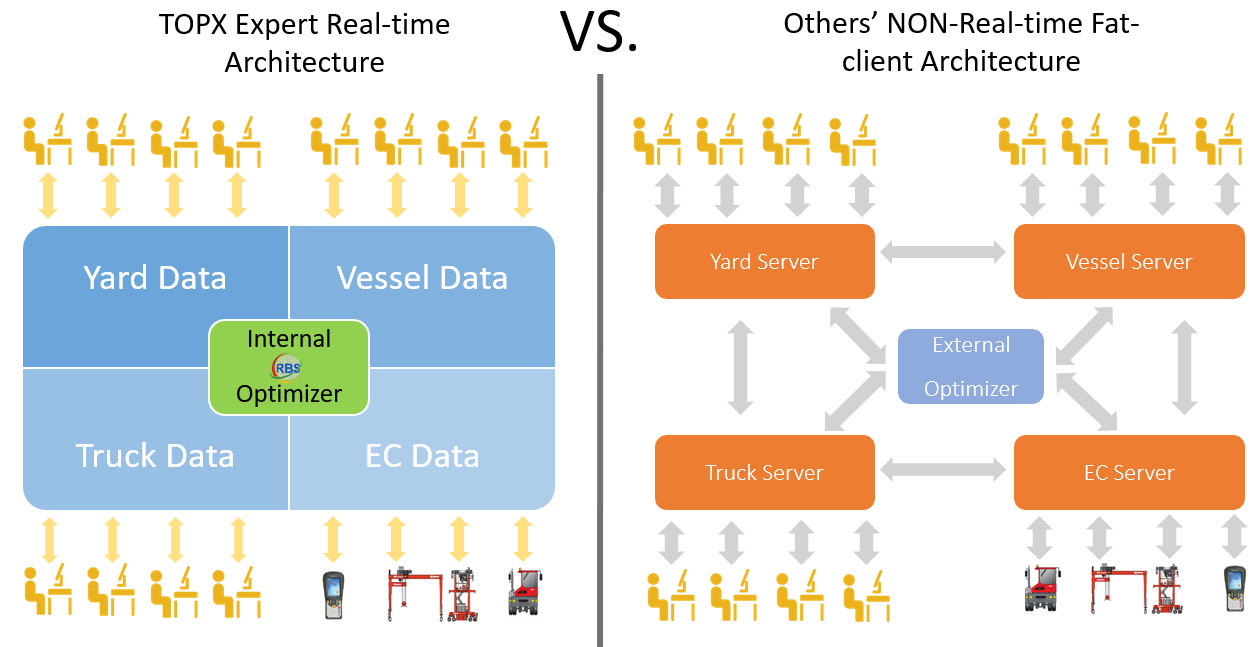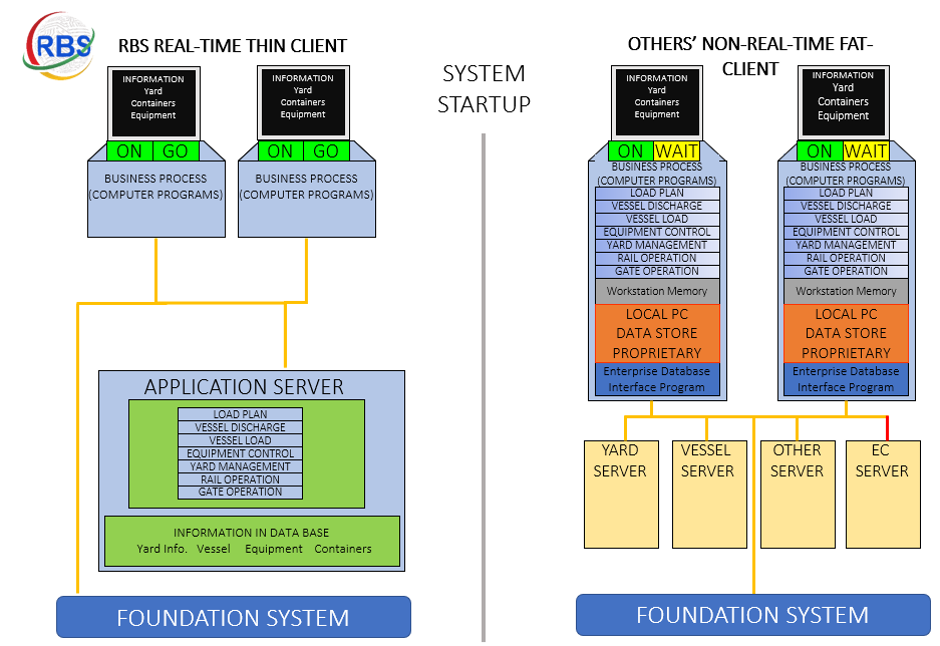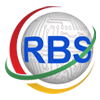The Importance of Real-time in a TOS
Real-time Architecture Enabling Shared Memory and In-memory
Rethinking Performance Management Post-Pandemic?
THE IMPORTANCE OF REAL-TIME IN A TOS
Highly volatile markets and constant fluctuations in environments highlight the criticality to exercise decisions devised from real-time data. These notions concern vital players of the supply chain as they cannot afford to partake in any mishaps due to the increasing constraints narrowing accessibility to resources and liberty to make mistakes. Real-time information, as a result, has become increasingly valuable as it serves as the foundation for a reliable system. Ports and terminals across the globe prioritise implementing safer practices in tandem with effective collaboration. This type of framework is possible when information collected, updates continuously; right from gathering data to the container handling equipment executing work instructions.
To limit a potential downturn, distinguish a pure real-time architecture from transaction processing. A common misconception assumes information obtained from the source at its current time as real-time. However, these semantics stray further from the true meaning of real-time since the data collected at the starting point can reform or change entirely once the system has inferred a plan or work instruction. The planning process broken down into simple steps include:
- Gather/input
- Process
- Decision-making/output
- Execute
Real-time data in its true meaning remains dynamic and is always in its most updated state, despite the stage of planning. Therefore, decision-making is agile and will always factor changes to reflect the status of the information collected. Pure real-time software has specific components and unique architecture which allow it to serve as a foundation for easy integration of further innovations.
DEFINITION
What is real-time? Distinguish between transaction processing (forged real-time) and true real-time.
The term “real-time” has been commonly misused to describe an environment that deviates from its meaning and tends to have conflicting constructs representative of transaction processing. An online transaction should not be confused with real-time since the system is oriented in a method that processes data statically and sequentially. As a result, operators cannot work on any tasks or continue the planning process until they have successfully downloaded and retrieved the data from the previous operator on the servers.
Transaction processing becomes increasingly complicated when workstation operators receive modified data, forcing the entire planning process to start from the initial stages. Sometimes the planning process continues without realizing the changes until CHEs have already received these instructions that are now deemed redundant, causing system hangs and erroneous moves from ensuing, which eliminates the chance for resource, CHE, and process optimization. Therefore, a transaction-oriented system has a strict structure that is not very reactive to changes, creating inflexibilities over control and removes agility in planning. A system architecture of this type is not feasible for running terminal operations and is not the pragmatic approach for operators who need reliable information to make accurate decisions.
Unlike the conventional TOS, RBS TOPS Expert is built on a true knowledge of real-time architecture, which ensures that data is always in its most updated state. Without interaction, TOPS Expert can be updated continuously, so that information flow is consistent and fast without being prone to fragmentation. The true real-time nature reinforced in TOPS Expert is owed by its unique centralized server infrastructure which facilitates parallel processing, allowing an operator to move a container even while another operator is controlling the same container data – a rarity for standard TOS’. As multiple windows and application processes can run in simultaneity, the workload is divided, inherently driving performance targets to new heights.
Although very few understand its true meaning, a system with a genuine real-time environment alerts another operator who intends to use the same data that it is actively used at a different workstation before they even confirm the action. Therefore, all activity conducted during planning to operation stages is registered in the system continuously so that concurrent planners are not using obsolete data. As information in TOPS Expert is always in real-time, any alterations in data are also automatically adjusted accordingly, so every stage of the planning process remains unaffected due to its independence and unique parallel graphic design.
TOPS Expert is conceived from a centralized infrastructure that facilitates real-time processing, which serves as the pillars that streamline processes, optimize resources, and makes accurate decisions. It has also generated core building blocks which ease the integration of new technological advancements like the Cloud, Automation, and Artificial Intelligence and has contributed an expanse in TOPS Expert capabilities. Only due to this architecture is RBS able to break conventional barriers and go beyond the known landscape to create innovations valuable for terminals. Understanding the architecture of your TOS is crucial in determining whether the roadmap can lead you to a prospective future. Your TOS is your future.
TRUE REAL-TIME VS. FORGED REAL-TIME ARCHITECTURE
Improved decision-making abreast enhanced operations implores the need for real-time. Only then can accuracy and precision derive from the decisions made within a terminal. However, building a real-time connection without understanding the very depths of its architecture, represses an accurate depiction. It is vital to differentiate from true real-time and forged real-time as it will assist in identifying key problem areas terminal operators currently face.

REAL-TIME ARCHITECTURE ENABLING SHARED MEMORY IN MEMORY
A system architecture purely in real-time can strengthen and cultivate a platform open to limitless capabilities. TOPX Expert, a graphical container planning, monitoring, and control system has accomplished an accurate depiction of a real-time architecture which has made shared- and in-memory possible. It has primarily served as the foundation for expanding capabilities into new horizons like Automation in the Cloud, the Cloud itself, and Artificial Intelligence. Due to recent events compromising existing practices and frameworks, RBS has realized greater importance to sustaining an authentic real-time architecture for efficient communication and optimization in all terminal aspects.

TOPX Expert is a proven solution and reputable for being true to a real-time architecture that can facilitate startups ready for operation with virtually zero wait time. A comprehensive TOS solution immediately loaded upon startup is credited by the single server infrastructure enabling shared memory. These conventions starkly contrast against traditional TOS’ which generally requires gathering and downloading data from multiple servers then re-uploading the information once an action is confirmed.
When more data is necessary for planning, the steps for information retrieval will take longer. This directly proportional relationship mirrors transaction processing as it incurs a static and sequential queue of work instructions and renders more extended periods of execution due to completing one task at a time. Consequently, data is also likely to become obsolete by the time CHEs receive these work instructions as vessel data or container data can change at any stage of the planning process. Further complications arise from decisions derived from fragmented data as it not only is liable to numerous errors but can accumulate into problems which enforce strategies criticized for its resource-intensiveness.
However, shared memory maintains data integrity and data interoperability while in-memory immediately loads all windows previously worked on in the last TOPX Expert session. All steps taken for downloading and re-uploading is eliminated with in-memory, accelerating data processing to grant greater control for better decision-making. From this architecture, collaboration on tasks is possible, dividing the total workload into smaller and manageable tasks. Flexibility in planning is also a result of TOPX Expert sustaining a combination of real-time, shared-memory, and in-memory processing. Faster task completion rates inherently evoke an enhancement in operational efficiency.
Time is a standard metric used to measure performance and degree of efficiency in terminal operations. RBS dedicates immense efforts to developing software that addresses the complete operational spectrum, using time as the most valued factor shaping the architecture and overall infrastructure of the TOS. By fulfilling time value requirements in TOPX Expert, processes, and operations streamline, which result from shared memory instigating faster startup times.
Real-time processing ultimately strengthens the infrastructure of TOPX Expert in accelerating the benefits of increased workflow and data sharing. Therefore, the differences depicted from transaction processing requiring micro-planning is incomparable with real-time processing as it enables shared memory for macro-planning, allowing terminals to experience higher cost savings.
RETHINKING PERFORMANCE MANAGEMENT POST-PANDEMIC?
Performance for industry stakeholders has struggled to meet desired targets, both operational and economical, due to the ongoing chain of unprecedented events. Underperformance has been the result of changes in a combination of labor costs, compliance costs, and logistics costs incurred from the movement of goods during the pandemic.
When dealing with different challenges, naturally, detecting the source of the issue can be difficult. Therefore, early identification of potential downturns is extremely valuable in times of uncertainty. Introducing a Key Performance Indicator (KPI) management tool to analyze the current activity will offer instant oversight on key figures of the core business areas of the terminal, covering all assets of waterside and landside operations.
An immediate snapshot of terminal performance can determine areas of complications and facilitate decision-making for resource planning, which helps achieve optimization. The results must extract meaningful data and maintain its real-time nature even in its final output. Otherwise, charts and graphs may conjure incorrect information, and from an operational and strategic standpoint – something you definitely should avoid.
TOPS KPI tool built on a pure real-time- and cloud-architecture makes valuable information readily accessible anywhere at any given time. The interoperability between a TOS and this remote management and data analysis tool enables TOPS KPI to explain outputs in easily understandable formats such as graphs and charts. These charts facilitate detection of areas of concern, as well as, operations that are experiencing high efficiency. Fulfilling these conventions, TOPS KPI grants access to daily processes and outputs of your business, not only to ensure the terminal is running smoothly but also, to fix issues before they evolve and impact performance. However, some primary benefits that distinguish against peers include:

Detailed
Visibility

Data Extraction

Operational
Analysis

BetterDecisions

Save
Time

